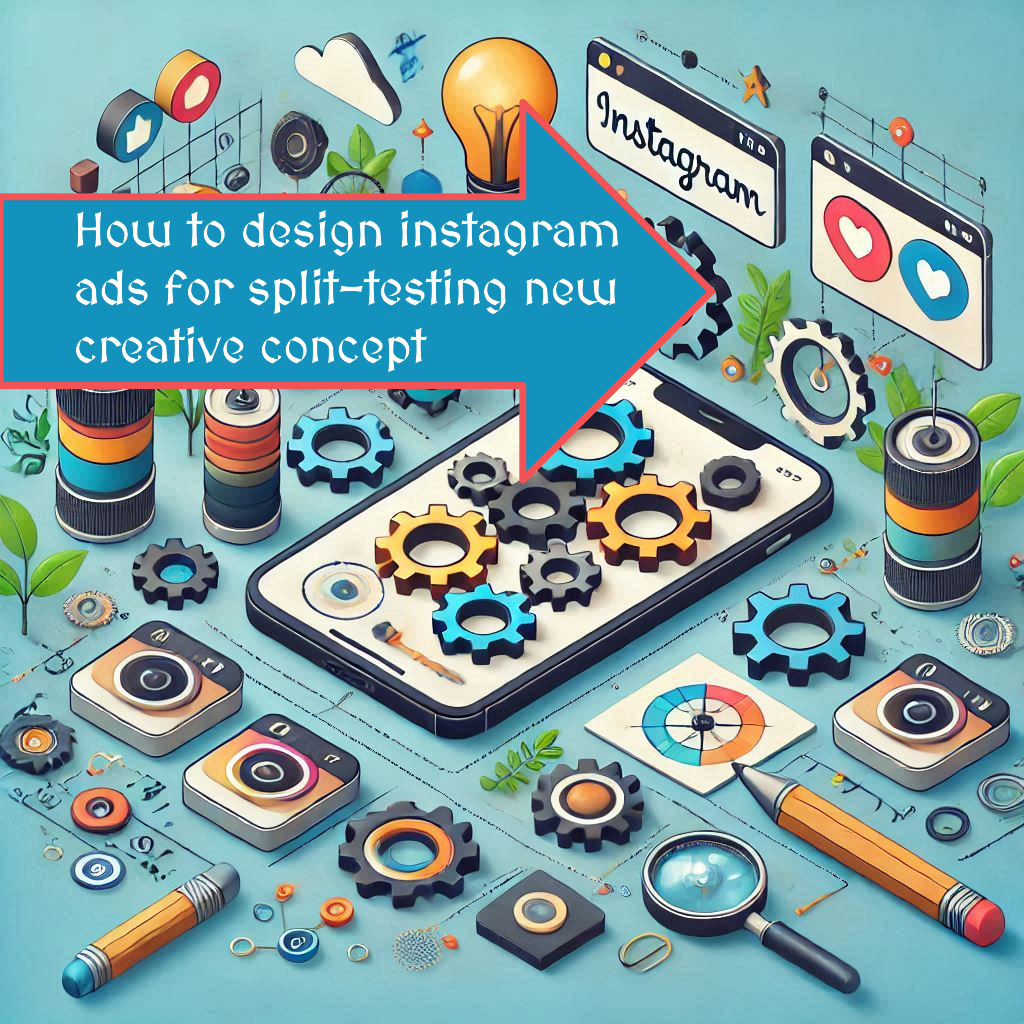Last Updated on January 13, 2025 by Val Razo
Split-testing, also known as A/B testing, is a critical strategy for any marketer aiming to optimize ad campaigns and maximize return on ad spend. At its core, creative testing allows businesses to compare different ad creatives—whether it’s the color of the text, ad copy, or creative format—to see which approach resonates with the audience. Whether you’re testing static ads, video ads, or UGC ads, this approach can help reduce creative fatigue, lower cost per action (CPA), and improve conversion rates.
By leveraging tools like Meta Ads Manager, marketers can set up split tests and test one element at a time. This allows businesses to test different creative elements systematically and compare two versions of an ad, helping them make more informed decisions about their testing strategy.
In this guide, we’ll break down how to design Instagram ads for creative testing, highlight best practices for creative testing, and explain how to gain insights for future campaigns. Let’s get started!

What Is a Creative Test and Why Is It Important?
Creative testing is the process of running different ad creatives to determine which one resonates best with your audience and supports your business goals. It enables marketers to make data-driven decisions by identifying elements that lead to higher conversion rates, lower cost per action (CPA), and improved return on ad spend (ROAS).
Key Benefits of Creative Testing
- Identify What Resonates: By testing two versions or different combinations of creative, you can find out what content truly connects with your audience.
- Reduce Creative Fatigue: Introducing fresh creative elements, like UGC ads, helps maintain engagement and avoids repetitive messaging.
- Lower Costs: Testing can reduce cost per purchase by identifying effective creatives that drive conversions.
Examples of Creative Testing
- Testing one variable at a time, such as a call to action, ad copy, or image format.
- Using Meta Ads Manager to compare two different ads with variations in creative assets, like static images vs. videos.
- Trying out UGC ads versus professional content to see which resonates better with your audience.
Creative testing helps refine marketing strategies by enabling businesses to make smarter, data-backed decisions. It’s important to test regularly to gain insights and stay competitive in the dynamic world of social media posts and Instagram ads.
In my recent campaign, I decided to test two different ad formats: a static image and a short video. Initially, I believed the video would outperform the image due to its dynamic nature. However, after running the ads for a week, I noticed that the static image garnered a higher click-through rate. This experience taught me the importance of not making assumptions and the value of testing each creative element to see which one performs better.
Setting Up Your Split-Test: Best Practices for Creative Testing
Designing an effective split test for Instagram ads requires a well-structured testing strategy and adherence to best practices for creative testing. By systematically testing different ad creatives, you can identify which elements drive the best results.
1. Define Clear Goals
- What do you want to test? For instance, are you focused on reducing cost per purchase, improving conversion rates, or identifying which creative assets resonate with your audience?
- Align your tests with your business goals to ensure every test yields actionable insights.
2. Start With One Variable
- Testing one element at a time—like the color of the text or the call to action—helps isolate the impact of that specific element.
- For example, you can compare two versions of an ad with identical visuals but different headlines to see which performs best.
3. Use the Right Testing Tools
- Meta Ads Manager simplifies the creative testing process by allowing you to run controlled split tests. It also tracks key metrics like cost per action and conversion rates to identify a winning creative.
4. Segment Your Audience
- Testing on different audience segments can reveal how specific marketing strategies perform across demographics.
- For example, a UGC ad may resonate more with younger audiences, while static ads might work better for older demographics.
5. Monitor Key Metrics
- Focus on metrics like CPA, conversion rates, and return on ad spend to measure success. Ensure you reach statistical significance before drawing conclusions.
By following these testing best practices, you can optimize your campaigns, reduce creative fatigue, and gain insights for future campaigns.

Designing Instagram Ad Creatives for Maximum Impact
To maximize the effectiveness of your creative testing efforts, it’s crucial to design ads that capture attention, engage your audience, and drive conversions. Testing different ad creatives with high-performing elements allows you to uncover what resonates most and optimize campaigns for the best results.
Elements of High-Performing Ad Creatives
- Strong Visuals:
- Use eye-catching images and videos that stand out in users’ feeds. Test the use of static ads versus video ads to identify which performs better.
- Experiment with color of the text, font styles, and overlays to enhance visibility.
- Clear Call to Action (CTA):
- A compelling call to action like “Shop Now,” “Learn More,” or “Get Started” encourages users to take the next step.
- Test different CTAs to find the one that aligns with your audience’s needs.
- Relatable Content:
- Ads featuring UGC often outperform polished, professional ads because they feel more authentic.
- Incorporate social proof through UGC ads that showcase real customers using your product or service.
- Tailored Ad Copy:
- Write concise, engaging ad copy that highlights the value of your product or service.
- Test different versions of headlines or captions to identify what drives the highest conversion rates.
- Mobile-First Design:
- Optimize creatives for mobile devices, ensuring text and visuals are easily viewable on smaller screens.
As of 2023, Instagram’s advertising audience consists predominantly of users aged 18 to 34, accounting for 61% of the total advertising audience.
Examples of UGC in Instagram Ads
User-generated content (UGC) is an impactful strategy for creating relatable and authentic ads. Here are examples of how brands successfully use UGC ads on Instagram:
- Customer Reviews in Video Ads:
A skincare brand might feature a video of a real customer describing their positive experience with the product. This format builds trust and often reduces the cost per action (CPA) compared to polished corporate ads. - Social Media Posts as Ads:
Use testimonials or photos from loyal customers showcasing your product in real-life situations. These creative assets are cost-effective and foster a sense of authenticity. - Collaborations with Influencers:
Collaborate with micro-influencers to create UGC ads that showcase your product in relatable, everyday scenarios. - Before-and-After Comparisons:
Highlight transformations or improvements through UGC visuals to engage users and drive conversion rates.
Incorporating these strategies into your creative testing process ensures you are testing relatable and impactful content that truly connects with your audience.

Analyzing Results and Optimizing Future Campaigns
Properly analyzing the results of your creative testing efforts is critical for understanding what works and how to improve future ad campaigns. By tracking key metrics and leveraging insights, you can refine your testing strategy and align future creative assets with your business goals.
Metrics to Track During a Creative Test
Monitoring the right metrics ensures you gather actionable data to identify a winning creative. Key metrics include:
- Cost Per Action (CPA):
- Track the amount spent to achieve specific actions, such as clicks, leads, or purchases. Lower CPA indicates more efficient creative testing efforts.
- Conversion Rate:
- Measure the percentage of users who take the desired action after viewing your ad. Ads with higher conversion rates typically resonate better with the audience.
- Click-Through Rate (CTR):
- A higher CTR shows that your ad copy and visuals are effective at capturing attention and prompting users to engage.
- Return on Ad Spend (ROAS):
- Evaluate how much revenue your ads generate compared to the spend. This metric highlights the profitability of your tested creatives.
- Engagement Metrics:
- Likes, comments, and shares are important for gauging user interest and identifying which creative elements spark engagement.
- Cost Per Purchase:
- For e-commerce campaigns, track this to understand which creatives drive sales at the lowest cost.
After several months of running the same ad creatives, I noticed a decline in performance metrics, indicating creative fatigue. To combat this, I collaborated with my creative team to develop fresh content, including new visuals and updated ad copy. Implementing these changes revitalized our campaign, leading to a 30% improvement in conversion rates.
Using Insights to Improve Future Campaigns
The data collected from your split tests is a goldmine of insights that can guide the development of future campaigns. Here’s how to leverage those insights:
- Double Down on High-Performing Creatives:
- Identify the ad set or one version that performed best during the test. Use this as a benchmark for designing future ad creatives.
- Eliminate Underperforming Elements:
- If a particular call to action or visual doesn’t deliver, avoid using similar creative strategies in the future.
- Segment and Personalize:
- Analyze how different audience segments responded to various creatives. For example, if video ads perform better with younger audiences, focus on video content for that demographic.
- Incorporate UGC Ads:
- If UGC ads delivered higher conversion rates, consider making them a core part of your testing strategy. These relatable and authentic formats often outperform traditional ones.
- Iterate and Innovate:
- Don’t stop at one successful test. Regularly test new ad creatives, ad copy, and formats to adapt to audience preferences and reduce creative fatigue.
- Use Data to Align with Business Goals:
- Insights from your tests can help prioritize business goals, such as growing new followers, lowering acquisition costs, or improving cost per conversion.
By focusing on these metrics and applying the lessons learned, you’ll continuously improve your campaigns and optimize ad campaigns for long-term success. Creative testing helps refine your marketing strategies and empowers you to create content that resonates with your audience.

Using UGC Ads to Find a Winning Creative Concept
User-generated content (UGC ads) has emerged as a powerful tool for engaging audiences on Instagram. These ads leverage authentic, relatable content created by real users, which often outperforms traditional ad formats. By incorporating UGC into your creative testing efforts, you can discover what resonates with your audience and optimize campaigns for better results.
Why UGC Ads Outperform Traditional Formats
- Authenticity Builds Trust:
- UGC ads feature real users, making the content feel relatable and genuine. This authenticity increases engagement and helps reduce cost per action (CPA).
- Higher Engagement Rates:
- Users are more likely to engage with UGC ads because they mirror organic content rather than appearing overly promotional. This can boost click-through rates (CTR) and drive conversions.
- Relatability Enhances Performance:
- UGC ads often reflect real-world scenarios, making them more appealing to viewers. They help brands identify content that resonates with their audience, especially when compared to polished, corporate-style ads.
- Cost-Effective Content:
- Repurposing social media posts and testimonials reduces production costs while still delivering high-performing ad creatives.
- Combat Creative Fatigue:
- Since UGC ads are highly adaptable, they help refresh your campaigns and keep your content relevant for various audience segments.
In 2023, the Ukrainian edtech startup Headway implemented AI tools like Midjourney and HeyGen to enhance their ad creatives. This strategic move led to a 40% improvement in their video ad return on investment. By utilizing AI for tasks such as subtitles, voiceovers, and image generation, Headway efficiently expanded its user base across platforms like Instagram and Facebook.
Tips to Source Quality UGC for Your Campaigns
Creating effective UGC ads starts with sourcing content that feels authentic and aligns with your business goals. Here are some strategies to get started:
- Collaborate with Influencers:
- Partner with micro-influencers who have a strong connection with their followers. Their content often carries higher credibility and delivers better conversion rates.
- Engage Your Loyal Customers:
- Encourage satisfied customers to share their experiences by running contests or incentivizing reviews. These social media posts can serve as the foundation for UGC ads.
- Leverage Product Reviews and Testimonials:
- Use existing reviews, unboxing videos, or transformation photos to showcase the value of your product. These formats often resonate with viewers and improve cost per purchase.
- Create a Branded Hashtag:
- Introduce a campaign-specific hashtag to encourage users to create and share content related to your brand. This not only generates UGC but also boosts brand visibility.
- Request Usage Rights:
- Always seek permission from users before featuring their content in UGC ads. Offer incentives, like discounts or exclusive perks, to make participation appealing.
- Test UGC Across Formats:
- Run split tests to determine whether images, videos, or carousels of UGC deliver better performance. Combine this with other testing strategies for deeper insights.
Incorporating UGC ads into your creative testing process can help you uncover winning concepts that not only perform well but also build stronger connections with your audience. Their authenticity, cost-effectiveness, and adaptability make them an essential component of any successful testing strategy.

Conclusion
Creative testing is an essential process for optimizing Instagram ad campaigns and ensuring your content resonates with your audience. By strategically implementing split tests and focusing on best practices for creative testing, marketers can lower costs, improve conversion rates, and make more informed decisions for future campaigns.
The use of UGC ads has revolutionized how brands connect with their audiences, offering authenticity and relatability that traditional formats can’t match. By sourcing high-quality user-generated content and running systematic tests, you can identify winning creative strategies that align with your business goals and drive long-term success.
Remember, the key to effective testing lies in analyzing the right metrics, such as CPA, ROAS, and conversion rates, while continuously refreshing your creative assets to combat creative fatigue. By leveraging tools like Meta Ads Manager, testing different ad creatives, and optimizing based on insights, you’ll set the foundation for impactful and sustainable marketing efforts.
Start your creative testing process today, and unlock the potential of Instagram ads that truly resonate with your audience.
Frequently Asked Questions
What is multivariate testing, and how is it different from A/B testing?
Multivariate testing involves testing multiple variables (e.g., headline, image, CTA) simultaneously to see how they interact and impact performance. In contrast, A/B testing focuses on testing one variable at a time to identify which version performs better. Multivariate testing provides more complex insights but requires a larger audience for statistically significant results.
What are the best ways to test creative variations for Facebook ads?
Some effective ways to test creative variations include:
- Testing two different formats, such as video vs. static images.
- Experimenting with one ad element at a time, such as changing the headline, visuals, or CTA.
- Segment your audience and run targeted tests on Facebook and Instagram to identify performance trends across demographics.
How can I involve my creative team in the testing process?
Your creative team plays a vital role in ad testing by:
- Designing multiple variations of creative elements for testing.
- Analyzing performance metrics to understand what resonates with the audience.
- Regularly refreshing kind of content to reduce ad fatigue and maintain engagement.
Collaboration ensures the ads align with both creative vision and marketing goals.
How does creative testing help with overall business growth?
Creative testing enables businesses to:
- Identify what kind of content drives conversions and supports business goals.
- Reduce cost per action by focusing on high-performing creatives.
- Optimize campaigns to maximize your creative output and improve long-term ROI.
By identifying what one performs better, brands can create ads that align with audience preferences and drive measurable results.
How can testing reduce ad fatigue and improve campaign longevity?
Frequent creative testing allows marketers to:
- Refresh every creative by introducing new visuals, copy, or formats.
- Rotate content to avoid overexposure of one ad or style.
- Use insights to design ads that maintain engagement while staying aligned with audience preferences.
By consistently trying testing different approaches, you can reduce ad fatigue and extend the effectiveness of your campaigns.
Author Bio
Val Razo
Val Razo is a skilled professional in the field of Instagram Marketing. With over five years of experience as a freelance Social Media Marketing consultant, Val has assisted numerous small and medium-sized businesses in achieving their goals.
